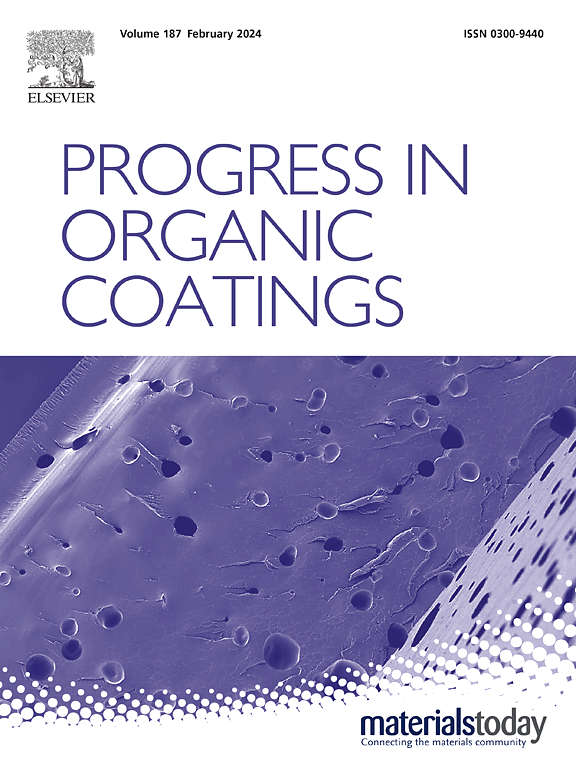硅烷基涂层纳米铝的稳定性和氧化反应分子动力学研究
IF 6.5
2区 材料科学
Q1 CHEMISTRY, APPLIED
引用次数: 0
摘要
在烃基液体燃料中引入高能铝纳米颗粒(ANPs)可以提高能量密度和燃烧效率。然而,它们在储存温度下聚集和氧化的强烈倾向带来了重大挑战,影响了分散稳定性和燃料性能。本研究通过实验合成和反应分子动力学(MD)模拟相结合,研究了硅烷涂层在缓解这些挑战方面的有效性。实验中,FT-IR分析和沉降试验证实了十八烷基三乙氧基硅烷(OTES)、三乙氧基(辛基)硅烷(TEOS)、(3-氨基丙基)三乙氧基硅烷(APTS)和三(三甲基硅氧基)硅烷(TMSS)在ANPs上的成功吸附,其中OTES在碳氢燃料中表现出最高的分散稳定性。MD模拟进一步揭示了表面涂层中的原子级反应步骤,强调OTES经历C-O键解离,形成Al-O-Si键,增强其与ANPs的粘附力。RDF分析表明,在多个涂层循环中,表面覆盖率逐渐增加,形成稳定的疏水层,有效防止水诱导的水解和氧化。另外的MD分析证实,OTES-ANPs在高温(2000 K)下抑制聚集和烧结,同时通过使涂层自脱离来提高氧化效率。这些发现表明,硅烷涂层,特别是OTES涂层,在高能量密度燃料应用中稳定金属纳米颗粒、减轻氧化和优化燃烧性能方面具有很好的前景。本文章由计算机程序翻译,如有差异,请以英文原文为准。
Combined experimental and reactive molecular dynamics study on stability and oxidation of aluminum nanoparticles with silane-based coatings
The introduction of high-energy aluminum nanoparticles (ANPs) into hydrocarbon-based liquid fuels enhances energy density and combustion efficiency. However, their strong tendency to aggregate and oxidize at storage temperatures poses significant challenges, affecting dispersion stability and fuel performance. This study investigates the effectiveness of silane coatings in mitigating these challenges through a combination of experimental synthesis and reactive molecular dynamics (MD) simulations. Experimentally, FT-IR analysis and sedimentation tests confirm the successful adsorption of octadecyltriethoxysilane (OTES), triethoxy(octyl)silane (TEOS), (3-aminopropyl)triethoxysilane (APTS), and tris(trimethylsilyloxy)silane (TMSS) onto ANPs, with OTES exhibiting the highest dispersion stability in hydrocarbon fuels. MD simulations further reveal atomic-level reaction steps in the surface coating, highlighting that OTES undergoes C–O bond dissociation, forming Al–O–Si linkages that strengthen its adhesion to ANPs. RDF analysis demonstrates a progressive increase in surface coverage across multiple coating cycles, leading to a stable hydrophobic layer that effectively prevents water-induced hydrolysis and oxidation. Additional MD analyses confirm that OTES-ANPs suppress aggregation and sintering at elevated temperatures (2000 K), while improving oxidation efficiency by enabling the self-detachment of the coating. These findings establish silane coatings, particularly OTES, as a promising strategy for stabilizing metal nanoparticles in high-energy-density fuel applications, mitigating oxidation, and optimizing combustion performance.
求助全文
通过发布文献求助,成功后即可免费获取论文全文。
去求助
来源期刊

Progress in Organic Coatings
工程技术-材料科学:膜
CiteScore
11.40
自引率
15.20%
发文量
577
审稿时长
48 days
期刊介绍:
The aim of this international journal is to analyse and publicise the progress and current state of knowledge in the field of organic coatings and related materials. The Editors and the Editorial Board members will solicit both review and research papers from academic and industrial scientists who are actively engaged in research and development or, in the case of review papers, have extensive experience in the subject to be reviewed. Unsolicited manuscripts will be accepted if they meet the journal''s requirements. The journal publishes papers dealing with such subjects as:
• Chemical, physical and technological properties of organic coatings and related materials
• Problems and methods of preparation, manufacture and application of these materials
• Performance, testing and analysis.
 求助内容:
求助内容: 应助结果提醒方式:
应助结果提醒方式:


